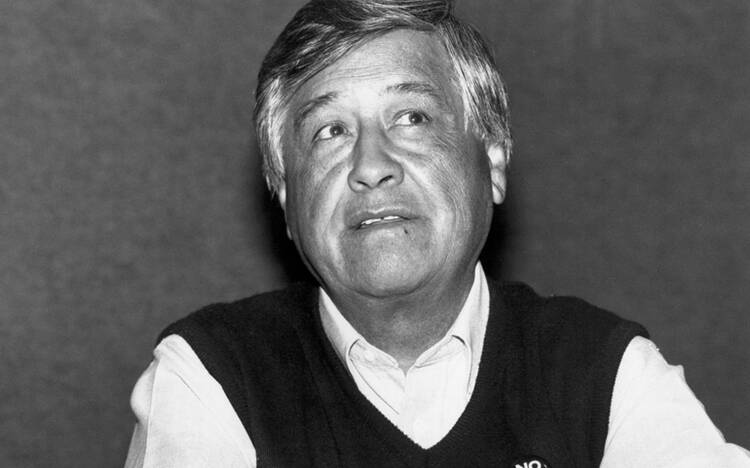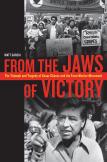A Legend Unraveled
In the Epilogue to his From the Jaws of Victory, a narrative about Cesar Chavez and the farm workers movement, the labor historian Matt Garcia repeats a line from John Ford’s classic western, “The Man Who Shot Liberty Valence.” Although Ransome Stoddard (played by Jimmy Stewart), received credit for killing the notorious criminal Valence, he did not actually kill him. This unearned and undeserved notoriety nevertheless enabled Stoddard to leverage his way from small town Shinbone, Ariz., into fame, fortune and a seat in the United States Senate. Years later, after Valence’s real killer had died, Stoddard tried to set the record straight for a newspaper editor, who refused to print the confession. Believing that the public would prefer the myth, he explained to Stoddard, “When the legend becomes fact, print the legend.”
Cesar Chavez is widely considered a great American hero. Since his death in 1993, some 52 schools, 37 parks, 57 libraries and 82 streets have been given his name. Bill Clinton posthumously presented him the Medal of Freedom, and across the nation, his birthday, March 31, is designated as Cesar Chavez Day. Chavez was certainly not a fraud. As Garcia explains in this somewhat dense and plodding chronological narrative of the movement’s organizational dynamics and leadership, Chavez’s leadership was sincere, often virtuous, and the movement as a whole demonstrates “the capacity of consumers and volunteers to take action in the interest of people far removed from them.” Nevertheless, Chavez was also a deeply flawed autocrat, and these flaws were instrumental in dismantling the immense gains of the movement at its height, raising important questions about the American obsession to prefer legend to truth when anointing national heroes.
This work can be read as a three-act tragedy that homes in on how power and its abuse can corrupt individuals and institutions. First we encounter the young former farm worker and navy man Chavez, who, in the late 1960s emerges as a master of community organizing in the tradition of Saul Alinsky. Motivated by Franciscan spirituality, the more progressive side of Catholic social teachings and the non-violent example of Ghandi, Chavez has charisma, dedication and the flexible leadership skills that help him recruit and empower a talented group of student volunteers and dedicated social activists. We are introduced to a cadre of very diverse, often quirky personalities, including Delores Huerta, Gilbert Padilla, the Protestant clergymen Chris Hartmire and Larry Drake, Larry Itliong and Elaine Elinson, among many others, who manage to work together in the tedious trench warfare of creative nonviolence that characterized the early days of the movement that came to be known as la Causa.
Beginning with the successful Tulare rent strike in 1965, through the Delano grape boycott and secondary boycott that finally brought the growers to the bargaining table, the movement became a force to reckon with. By the time California’s Agricultural Labor Relations Act was passed in 1975, giving agricultural workers the right to negotiate conditions of their employment, Chavez’s United Farm Workers of America, now designated a union, was already representing a significant segment of the farm labor work force. The future seemed very bright.
This work can be read as a three-act tragedy that homes in on how power and its abuse can corrupt individuals and institutions.
Both internal and external forces almost immediately began to rip apart the movement’s successes, however. In this second phase of the drama, we see the pro-Nixon teamsters trying to nudge the farm workers movement aside to take over and weaken farm worker contracts; huge Filipino-Mexican rivalries within the leadership of the union; conflicts over boycott strategies; and, most important, the crushing defeat of Proposition 14, the bill introduced to California voters to revive the A.L.R.A., which by 1976 had all but died due to legislative enemies cutting off funding. As Garcia explains it, the defeat of the proposition dramatically changed Chavez, and he began a downward spiral into psychological paranoia and erratic behavior.
As the final phase of the tragedy unfolds, Garcia introduces a very different leader who begins to balk at the increasing bureaucratization necessary for building a union and yearns for the days of marches, fasts and boycotts. Chavez closes ranks with an inner circle of devotees at La Paz, the union’s community-based headquarters and organizing training facility in Keene, Calif., and accuses many of his associates of being spies seeking to undermine his authority. Most significantly, he becomes enamored with Charles Deterich, known as Chuck, founder of the controversial and radical communal movement Synanon. Chavez implemented Deterich’s encounter group method, known as “the game”—a meeting in which one person is targeted by the rest of the group and repeatedly verbally assaulted to get him to break down and examine his life. Even after Synanon became a religious and personality cult and Deterich was arrested for attempted murder and kidnapping, Chavez continued his friendship with Deterich and began to purge the union of anyone at La Paz who refused to play the game.
Like Deterich, Chavez also began to see himself as a leader of a religious movement. With Catholic overtones, he implemented high holy days, martyr days and, most important, Founder’s Day, which coincided with Chavez’s birthday. On that day, Chavez was serenaded by mariachis and residents with the Mexican birthday song, followed by a special breakfast, Mass and an all-day celebration. He expressed the belief that eventually he and some of the movement’s leaders would be honored as saints.
With such bizarre activities, it did not take long for the gains of the union to unravel. Chavez became increasingly isolated from the union representatives working directly with the field workers and from union lawyers who represented them in Sacramento. After a few devastating investigative exposés of the activities at La Paz, Chavez began to lose the support of union leaders and friends, leading eventually to the U.F.W.’s joining the A.F.L.-C.I.O. in 1972 and the official ending of the grape boycott in 1978.
The immense gains achieved over a very short time by a group of dedicated organizers and a very charismatic leader tell us much about the plight of farm workers and the power of community organizing. At the height of the movement in 1975 field workers were able to negotiate double the minimum wage, vacations, unemployment insurance and a modest pension plan. But these gains were localized and short-lived. Today’s U.F.W. has very little power. In our postmodern version of The Grapes of Wrath, most field workers come from Mexico and Guatemala; most of them are illegal; and there is no federal program to protect them. They labor for $3 less than minimum wage and not one of them is under a labor contract. At present consumer attention is directed toward green living and healthy eating, and few consumers care about the farm workers who harvest what is eaten.
Meanwhile, the legend lives on. Last October, in the middle of his campaign to get the Hispanic vote, President Obama dedicated a national monument to Cesar Chavez at La Paz.
This article also appeared in print, under the headline “A Legend Unraveled,” in the June 3-10, 2013, issue.











